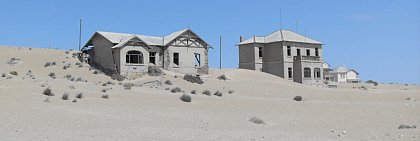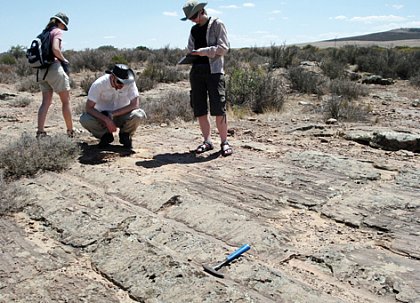Links
Contact
Prof. Dr. Gregor Borg
Institute of Geosciences
phone: +49 (0)345 55 26080
gregor.borg@geo.uni-halle.de
Von-Seckendorff-Platz
06120 Halle (Saale)
Login for editors
Where dunes and diamonds are king
Eventful student geology excursions to South Africa and Namibia
UTE OLBERTZ
Sleeping under the starry night sky, cooking outdoors and bathing in hot springs are just part of day-to-day business for members of an excursion, headed by Professor Gregor Borg from the Institute of Geosciences, that travelled from Cape Town to Windhoeck. The South Africa/Namibia tour at the beginning of March was pure adventure for the 16 geology students. They were able to gather practical experience and reinforce their theoretical knowledge through on-site observation. “In this landscape you can see and study deep layers of the earth’s crust right up here on the surface,” says Gregor Borg. “In other places, these rock layers are hidden 35 kilometres below ground.”

Homes from colonial times in the diamond city of Kolmanskop are seized by the dunes of the Namib Desert.
Photo: Dominik Rumpf
The excursion members clocked 5,300 kilometres in two VW busses and an all-terrain vehicle. Prior to starting the tour there was an eleven hour flight from Berlin to Cape Town. After arriving in Cape Town they spent their first two nights in a hostel. After that, sleeping was done outdoors. Staff member Dr. Manuela Fortzscher and rock preparator Gerald Bertolt, who were taking this route for the first time, were also among the group.
Travelling with Professor Borg means not only learning things for your education, but also experiencing and discovering the exciting things found on this earth: empty deserts, diamonds, raging rivers and, let’s not forget, scorpions. It was Borg’s fourth trip with a group to this region. They packed a complete supply of field equipment including cooker, dishes, thermal mats, sleeping bags and, of course, food supplies such as potatoes, noodles, meat, pumpkins and muesli. And don’t forget the fridge, as temperatures hovered around 28° C and even climbed once to 47° C.

Dr. Manuela Frotzscher, Alexander Schmidt and Katharina Dietz-Laursonn gaze at the 300-million-year-old glacial groves from the Dwyka Period in Nieuwoudville, South Africa.
Photo: Nadine Liebetrau
Rocks, rocks everywhere
The main point of the excursion was to show the applied geosciences students (the group was made up of bachelor, master and diploma students) the structure of the mountains and the deposits of raw materials found there. “The rocks of this landscape are visible everywhere due to the lack of soil and resulting sparse vegetation,” explains Borg. “The geology just jumps out at you constantly.”
Geology professor Marian Tredoux from the local University of Bloemfontein, guided the excursion members throughout the entire Cape Peninsula. The University of Bloemfontein signed a faculty-level cooperation agreement last year with the MLU. As one of the most renowned geoscientists in the country, she explained in detail the special features of the region. She is expected to come to Halle as a visiting professor during the 2011summer semester as part of a scientist exchange programme with South Africa.
On the itinerary were visits to the Cape of Good Hope, Table Mountain and Brukkaros Mountain, a pseudo-volcano that is the highest peak in southern Namibia. Among other things, there were 300-million-year-old glacial grooves. Not only geological, but also tourist highlights were on the agenda, like the new football stadium in Cape Town, built for the World Cup, and two oceans – the Atlantic and Indian Ocean.
The visit to the lead-zinc district “Rosh Pinah and Scorpion” in southern Namibia was also important. It is where Gregor Borg has been doing research for the past 10 years. Here so-called bio-ores can be found. These are ores which have lost their lead and sulphur content through geological processes that leave behind highly concentrated “clean” zinc silicates. For the first time, Borg was able to prove that the copper to isotope ratio changes very systematically due to such “cleaning processes”. This can be useful in the future when searching for new raw material deposits.

Sand dunes bury the old railway line from Aus to Lüderitz Bay and prevent new tracks from being laid.
Photo: Manuela Frotzscher
A scorpion in my sleeping bag
The group also went for two days in search of diamonds in canoes along the Oranje River, the river border between Namibia and South Africa, in order to study the river system. “This river has been transporting and selecting the large diamonds for ages and brings them from inland to the Atlantic coast,” says Borg who lost his camera when his canoe tipped over. At the time, the river was running high and fast. Some of the boats inevitably tipped over despite Sia and Bonnie their experienced river guides. After this thrilling experience for some members, the group reached the mountainous desert landscape of Richtersveld National Park unscathed. It is a place few visit because it is only accessible in this way. The diamond mining region is moreover well-secure and not accessible to the public.
A visit to the ghost town Kolmanskop near Lüderitz was impressive for everyone. It was an old diamond city founded in 1905 and unfortunately only a “temporary paradise” because the nearby diamond mines were quickly exploited. Once people left, the desert reclaimed the city and the winds covered it in sand. It wasn’t uncovered until the 1980s and is now accessible to tourists. Today its golden age is only reflected in the remains of its noble stone buildings. Streets and railway embankments, which end in the middle of a dune, are impressive sights.
Damage to the engine of the one all-terrain vehicle a few metres from Springbock challenged the improvisation skills and off-road capabilities of the group. The same holds true for the scare on the second to last night of the trip. A black scorpion crawled into the sleeping bag of one of the students and … stung her. The fact that everything turned out fine in the end could be down to Professor Borg’s secret recipe for such cases which is “keep calm and don’t panic!” In addition to the geological observation course and mineral studies, there was a great deal to learn for all who participated.
